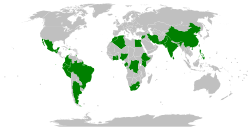Group of 24
This article relies largely or entirely on a single source. (February 2016) |
 | |
 Members of the Group of 24 as of 2019. | |
| Abbreviation | G-24 |
|---|---|
| Named after | Number of founding Member States |
| Formation | 1971 |
| Founder | Group of 77 |
| Founded at | Lima, Peru |
| Type | Intergovernmental trade bloc |
| Purpose | To aid in the coordination of the positions of developing countries on monetary and development issues |
| Headquarters | Washington, D.C., United States |
| Methods | Collective bargaining, lobbying, reports and studies |
| Fields | International trade |
Membership (2019) | 29 Member States |
Chair of the G-24 | |
Parent organization | Group of 77 |
| Affiliations | United Nations |
| Website | www.g24.org |
The Intergovernmental Group of Twenty-Four on International Monetary Affairs and Development, or The Group of 24 (G-24) was established in 1971 as a chapter of the Group of 77 in order to help coordinate the positions of developing countries on international monetary and development finance issues, as well as and to ensure that their interests are adequately represented in negotiations on international monetary matters. Though originally named after the number of founding Member States, it now has 28 Members (plus China, which acts as a Special Invitee).[1] Although the G-24 officially has 28 member countries, any member of the G-77 can join discussions.
Although the group is not an organ of the International Monetary Fund, the IMF provides secretariat services for the Group. Its meets biannually, first prior to the International Monetary and Financial Committee, and secondly prior to the Joint Ministerial Committee of the Boards of Governors of the Bank and the Fund. These meetings allow developing country members to discuss agenda items prior to these important meetings of the IMF/World Bank.
Member States[]

Following is the list of members of G-24:[1]
Region I (Africa):
Region II (Latin America and the Caribbean):
Region III (Asia):
Observers[]
The following act as observers states of the G-24:[2]
 Angola
Angola Indonesia
Indonesia Saudi Arabia
Saudi Arabia United Arab Emirates
United Arab Emirates
The following act as institutional observers of the G-24:[2]
- Arab Monetary Fund
- Economic Commission for Latin America and the Caribbean
- Group of 77
- International Labour Organization
- Islamic Development Bank
- OPEC Fund for International Development
- Organization of the Petroleum Exporting Countries
- South Centre
- United Nations Conference on Trade and Development
- United Nations Department of Economic and Social Affairs
- Central American Monetary Council
Operation of the G-24[]
The G-24 operates at two levels:
- The political level, consisting of Ministers, their Deputies, the Bureau, and other Washington-based representatives who participate in the Committee of the Whole and in any ad hoc meetings; and
- The operational level, which is run by the G-24 Liaison Office, and includes the G-24 Secretariat and the Research Coordinator.
The governing body of the G-24 meets twice a year, preceding the Spring and Fall meetings of the International Monetary and Financial Committee and the Joint Development Committee of the World Bank and the International Monetary Fund. The plenary G-24 meetings are addressed by the heads of the IMF and the World Bank Group as well as by senior officials of the UN system. Issues are first discussed by the Deputies and culminate at the Ministerial level by the approval of a document that sets out the consensus views of member countries. The Ministerial document is released as a public Communiqué at a press conference held at the end of the meetings. Decision-making within the G-24 is by consensus.
G-24 Research and Publications[]
The Group also maintains a research and work program that revolves around issues of importance to developing countries. In particular, the program focuses on three key areas: The global economy and growth agenda, international financial architecture, and financing for development. The global economy and growth agenda emphasizes structural transformation, trade and technology, and inequality. international financial architecture covers reform and governance of global financial institutions, the global financial safety net and managing capital flows, and financial regulation. financing for development includes taxation and international tax cooperation, infrastructure financing, debt management and sustainability, and financial inclusion. Much of the group's research, including books, policy briefs and working papers can be found on its website.[3]
Leadership[]
The following compose the leadership of the Group:[4]
- Chair: Akbar Komijani, Governor of the Central Bank of Iran
- First Vice-Chair: Sergio Recinos, Governor of the Bank of Guatemala
- Second Vice-Chair: Adama Coulibaly, Minister of Finance, Côte d'Ivoire
Chairs of the G-24[]
The following is the list of former and current Chairs of the G-24:
| Year | Chair |
|---|---|
| 2021 | |
| 2020 | |
| 2019 | |
| 2018 | |
| 2017 | |
| 2016 | |
| 2015 | |
| 2014 | |
| 2013 | |
| 2012 | |
| 2011 | |
| 2010 | |
| 2009 | |
| 2008 | |
| 2007 | |
| 2006 | |
| 2005 |
References[]
- ^ a b "Members". Intergovernmental Group of 24. Intergovernmental Group of 24. n.d. Retrieved 19 February 2019.
- ^ a b "Observers". Intergovernmental Group of 24. Intergovernmental Group of 24. n.d. Retrieved 19 February 2019.
- ^ "Working Papers | G-24". G-24. Retrieved 2018-11-13.
- ^ "Organizational Structure and Governance | G-24". G-24. Retrieved 2018-10-02.
External links[]
| Wikimedia Commons has media related to Group of 24. |
- Group of Eight
- Organizations established in 1971